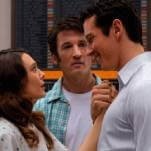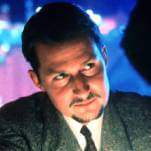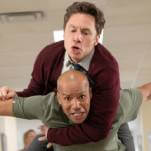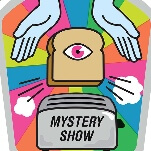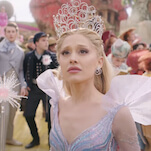My Year Of Flops Totally Tween Case File #118: Bratz: The Movie

During a recent vacation, I became strangely
addicted to the slow-motion train wreck that is A&E;'s The Two Coreys. In my favorite episode, Corey
Feldman, concerned that his tragicomic bud Corey Haim has become a hopeless
pill-popper, convinces Todd Bridges and Pauly Shore to confront the lesser
Corey about his substance abuse. As Bridges and Shore contemplate the task at
hand, they're overcome with a profound sense of life's ridiculousness. How on
Earth did they get there? What unspeakable crime did they commit in a past life
to merit this karmic mind-fuck? I'm pretty sure at least one of them was
Hitler, or at least a high-level Nazi. Even Pauly Shore, Todd Bridges, and
Corey Feldman found the prospect of a semi-intervention featuring Pauly Shore,
Todd Bridges, and Corey Feldman mind-boggingly insane. You know your life has
spun out of control when Pauly fucking Shore is lecturing you about
responsibility.
I know the feeling. There are times in
everyone's life when the randomness of fate smacks you dead in the face. Don
DeLillo, Kurt Vonnegut, and David Foster Wallace are/were masters at
chronicling the often ugly, sometimes sublime preposterousness of the way we
live. They allow readers to take a step back and see the things we all take for
granted in a new, disorientingly foreign light, to see the bizarre in the
familiar and the familiar in the bizarre.
I experienced a similarly uncanny sense of
life's absurdity when I sat down in a small, cold room on the 16th floor of a
nondescript building in downtown Chicago with a platoon of pasty, middle-aged
men to watch a series of flickering images and shiny, happy noise called Bratz: The Movie, a movie designed to sell a
popular line of skanky plastic dolls. Here's what the American Psychological
Association had to say about these plastic pop-tarts:
Bratz
dolls come dressed in sexualized clothing such as miniskirts, fishnet
stockings, and feather boas. Although these dolls may present no more
sexualization of girls or women than is seen in MTV videos, it is worrisome
when dolls designed specifically for 4- to 8-year-olds are associated with an
objectified adult sexuality.
Alas, those spoilsport eggheads in the APA
were no match for the Bratz spokesman (you gotta wonder who he killed in a previous life)
who defended the dolls with the withering retort, "The Bratz brand, which has
remained number one in the UK market for 23 consecutive months, focuses core
values on friendship, hair play, and a 'passion for fashion'."
Bruno Bettelheim argued persuasively that a
proper appreciation of "hair play" is a vital component of every child's
emotional development. And Abraham Maslow made a "passion for fashion" a
cornerstone of his hierarchy of needs. But The Bratz's inspiring message of hair
play, cultivating a passion for fashion, and friendship is largely wasted on
killjoys in the APA and film critics.
At the risk of being angrily
tossed out of the Fraternal Order Of Film Criticky-Type Folks, I willingly
confess that film critics, as a group, tend to look as if they just crawled out
of a sewer after engaging in spirited fisticuffs with an angry aggregation of
C.H.U.D.s. Though TV critics are invariably dandified fops who dress in the
latest fashions, print critics generally look like their ensembles were
purloined from the donation box at Salvation Army and thrown together by a
drunken blind man with a twisted sense of humor.
There's an evolutionary
explanation for the slovenly, vaguely feral appearance of the average film
critic. As a genus, they live and work in conditions of extreme darkness, not
unlike the similar but more aesthetically pleasing sewer rat. Like vampires,
critics shun the harsh light of the day. This is both because sunlight is new,
strange, jarring, and potentially fatal to them, and because it has an
unfortunate way of exposing to the world wardrobes composed largely of stained,
hole-ridden T-shirts promoting Pure Luck or The Air Up There, and sweatpants with elastic waists. Incidentally,
when I deride the fashion sense and hygiene of the average film critic, I'm
mainly, if not exclusively, talking about myself.
So to say that the folks at
the screening room were not the ideal audience for a movie about
clothing-obsessed teenaged girls would be a little bit of an understatement. When
the lights went down and the magic of cinema began, I had to wonder why Bratz was being screened for
critics at all. Did the Bratzketeers really expect us to
respond to their plastic product with anything other than snorts of disdain?
Couldn't Bratz:
The Movie just
as easily be titled Not
Screened For Critics: The Movie?









